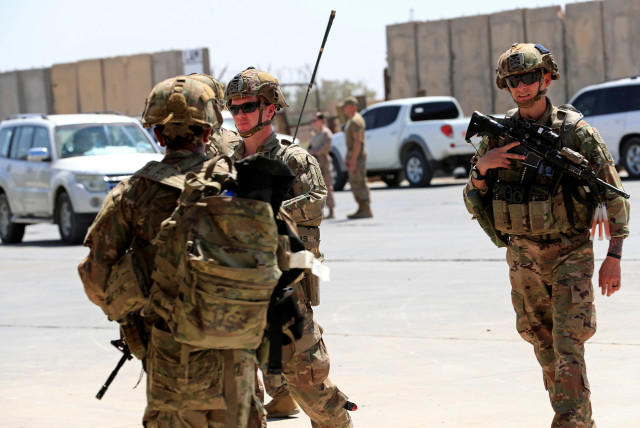US sends armored vehicles to Syria as carrier enters Persian Gulf
U.S. soldiers are seen during a handover ceremony of Taji military base from US-led coalition troops to Iraqi security forces, in the base north of Baghdad, Iraq August 23, 2020.
(photo credit: THAIER AL-SUDANI/REUTERS)
According to journalist Chad Garland the Bradleys are from the 2nd Brigade Combat Team of the 1st Armored out of Fort Bliss, Texas.
In a display of force the US-led coalition against ISIS dispatched Bradley armored vehicles from the 1st Armored Division in Kuwait to eastern Syria. They are supposed to “help ensure the safety and security of Coalition forces.” Armored units like this were sent to Syria last year after a US withdrawal from a part of northeast Syria. They were pulled out in January 2020, but now it appears the need for heavier tracked vehicles is necessary again.
US Central Command said it had directed a number of actions to ensure safety of US troops. There are only several hundred American soldiers in Syria according to official counts, but US patrols have been harassed by Russian patrols near Qamishli and other areas. The Russians moved into northeast Syria in October 2019 when the US withdrew from the border, which prompted a Turkish invasion. The Russians, even as they pressure the US, have kept Turkish-backed Syrian extremists from attacking and ethnically cleansing Kurdish minorities. Turkish-backed Syrian extremist groups have been accused by human rights and UN reports of widespread rape, looting and murder of women and minorities.
The Russian goal in eastern Syria is to undermine the US and bring the Syrian regime back to eastern Syria. Currently eastern Syria is stable under the US-backed Syrian Democratic Forces, of which the US trained around 80,000 fighters. The SDF defeated ISIS last year in eastern Syria and has administered a huge swath of areas east of the Euphrates river. They hunt down ISIS sleeper cells and keep ISIS suspects detained.
The US deployment of the Bradleys is designed to enable the SDF to continue keeping ISIS suppressed. This area is now called the Eastern Syria Security Area (ESSA), a new acronym. “These actions are a clear demonstration of US resolve to defend Coalition forces in the ESSA,” CENTCOM says. The announcement of the deployment was released by Col. Wayne Marotto, the new spokesperson of the coalition, and mentioned in a note by Captain Bill Urban at CENTCOM.
The US has also deployed Sentinel radar and increased fighter jet patrols, according to reports. The radar, among other things, can apparently be used to detect drone threats. US Central Command head Kenneth Mckenzie has warned about small drones being an increased threat.
According to journalist Chad Garland the Bradleys are from the 2nd Brigade Combat Team of the 1st Armored out of Fort Bliss, Texas. They had been stationed in Kuwait.
The vehicles were deployed in the wake of a crash with a Russian patrol in which a half-dozen US personnel were lightly injured. The Russians have been sending their own armored vehicles to chase after US patrols and conduct highway shenanigans which are a kind of constant pressure. The US officially is in eastern Syria to secure oil fields as well. Russian helicopters have become more aggressive, in late August buzzing US patrols to kick up dust. The Russians also incite locals and have sought bases in eastern Syria, reports indicate.
The fact it took three weeks to put the armored vehicles into Syria means that the Russian threat was not seen as a major emergency. However it appears the plan was in the works throughout the last weeks, it was unclear why it took so long. US President Donald Trump has said he could make another decision on Syria soon. He has already tried to withdraw US forces three times since early 2018. A US oil company is apparently involved in a recent deal in eastern Syria according to reports in early August. This leaves many questions about what might come next.
The US Navy and its 5th Fleet also brought the USS Nimitz into the Persian Gulf on Friday, according to Lucas Tomlinson of FoxNews. It sailed into the narrow waters alongside the guided-missile cruisers Princeton and Philippine Sea and the guided-missile destroyer Sterett. They transited the Straits of Hormuz on September, the 5th Fleet, which based in Bahrain, said
This Carrier Strike Group had been out in the Indian Ocean after coming from the Straits of Malacca in July. They came to the Middle East to have a carrier on station in the Gulf, as usual, to relieve the Eisenhower. The USS Ralph Johnson, a guided-missile destroyer, had been with this strike group in July, it was not clear if it entered the Gulf as well.
The overall news illustrates that the US is sending a message of strength during these tense times with Iran and Russia. Iran is seeking to show it is not deterred by having proxy groups fire rockets weekly against the US embassy and other American personnel in Iraq. Iran has also threatened US allies in Bahrain and the UAE in the wake of the peace agreements with Israel.






.jpeg)
Comments
Post a Comment